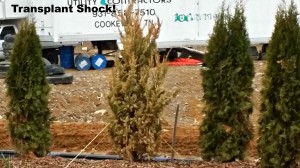A beautiful tree is bought and installed the same day. Two weeks (or two months) later the leaves are wilting or the needles are turning brown. What happened?
The plant is in transplant shock. What?
When it was planted or transplanted, something happened that increased plant stress tremendously. Wait, stress, shock, is this even real?
Yes, it sounds funny, but transplant shock happens on some level every time a plant is installed. The roots are happy before the install process occurs and become stressed when water in not applied regularly.
Think about it… plants are not designed to be moved!
Most transplant shock occurs from under-watering. If the roots aren’t happy and moist, then the entire plant suffers. It may take weeks of under-watering or incorrect watering techniques to become apparent. At that point of visual contact and confirmation, it may be too late.
Here’s how to avoid transplant shock.
- Start with a healthy plant. If the tree or shrub is wilted or looks sick at the garden center, don’t buy it.
- Dig a proper hole. That means two times wider than the root ball. Try to dig and install just one plant a day if you have a large project. Don’t get in a hurry here. I have stunted more plants because I became exhausted and cut corners.
- Install correctly. Remove the container (plastic pot) if applicable. If the tree is wrapped in burlap and/or a wire basket, DO NOT REMOVE. The burlap and basket protect the delicate roots from further stress. Apply appropriate amounts of water. You can’t over-water at the point of install. Make a moat!
- Add mycorrhizae at planting time. Mix with water for greatest effectiveness.
- Check the root ball every day for moisture with your finger. If needed, soak the root system.
If you follow the guidelines above, you’ll succeed 99% of the time. Good luck!
Question: What install methods have you found to be the most effective? Let me know on Facebook…





